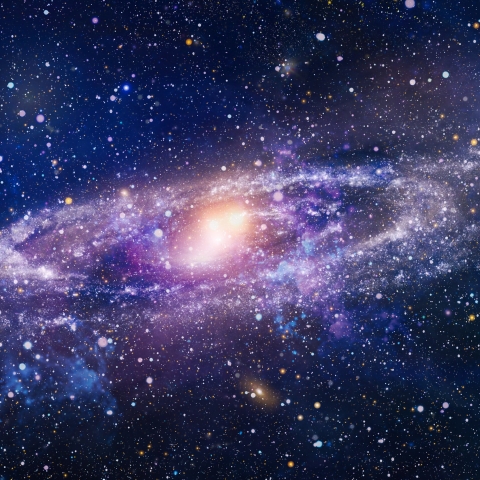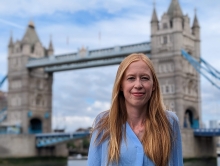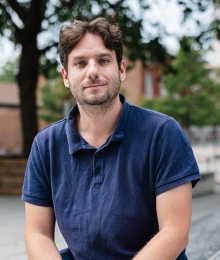
Gravitational waves research
Gravitational waves are an exciting new way to observe the universe. They were detected for the first time in 2015 when a gravitational-wave signal from two colliding black holes was detected by the Laser Interferometer Gravitational-wave Observatory (LIGO).
Since then, close to 100 signals have been detected from merging black holes and 2 signals originating from the coalescence of 2 neutron stars and 2 signals arising from neutron stars merging with black holes. Of particular note was the double neutron star merger named 'GW170817', which was observed across the electromagnetic spectrum, and was the first observation of an astronomical source with both electromagnetic and gravitational waves.
We develop increasingly sensitive and efficient techniques to detect gravitational waves from compact binary mergers. This will be especially challenging with future instruments, requiring us to develop innovative novel solutions.
We work on characterising the properties of the observed sources, and inferring the details of the astrophysical environments in which they formed. We also work on understanding the origin and effect of instrumental artefacts in the data recorded by the LIGO detectors, and develop techniques to mitigate their effect.
We work on using gravitational wave detections as tools to probe cosmology, such as measuring the expansion rate of the universe. We also use them as unique laboratories in which to test our fundamental understanding of Einstein’s General Theory of Relativity.
Our work has significant overlap with other areas of expertise in the Institute of Cosmology and Gravitation (ICG) at the University of Portsmouth:
- Gravitational waves and galaxy surveys act as complementary probes to study the large-scale structure of the universe and the laws which govern it.
- Multi-messenger astronomy, where we observe sources with both gravitational-wave and electromagnetic observatories, allows us to understand much more about the sources being observed.
- Observing gravitational-waves that have been “lensed” by distant massive galaxies, causing them to appear much closer than in reality, allows us to probe the distribution of such structure on the largest scales.
Our work explores the following topics
- Searches for compact binary mergers
- Parameter estimation
- Follow-up of mergers with telescopes like GOTO
- Detector characterization
- Cosmology with gravitational waves
- Testing the laws of gravity
The problems and issues that our research seeks to understand include:
- How many black holes and neutron stars are there in the Universe and how often do they collide? These objects, formed from the death of very massive stars, help us to understand the lifecycle of stars and galaxies and probe the environments in which collisions happen most often.
- How fast is our Universe expanding? One of the biggest open questions in modern astronomy is how fast is our Universe expanding. We know that it is expanding but there’s significant disagreements between measurements of how rapidly it is expanding. Gravitational wave observations offer us an independent measurement of this expansion parameter, which will help us to understand these disagreements.
- What goes on inside a neutron star? A neutron star is one of the most extreme objects in the Universe *almost* on the verge of collapsing into a black hole. Gravitational waves offer us a unique probe of the internal structure of these objects, allowing us measurements of the behaviour of matter under conditions which we could never reproduce on the Earth. A significant implication from the first observation of colliding neutron stars was that the majority of gold found on the Earth was likely produced by a neutron star merger in the distant past.
- Does gravity behave the same on the largest scales of the universe as it does on Earth? We have a standard theory of gravity, Albert Einstein’s General Theory of Relativity. But when applied to the universe as a whole it gives some bizarre answers. Could Einstein’s theory be just one part of a bigger picture about gravity? Gravitational waves, being inherently controlled by the laws of gravity, could reveal new clues about this fundamental law of nature.
Our methods
These problems require 'data intensive science' and 'big data' solutions. We are experts in time-domain signal processing, and in Bayesian statistics, including Bayesian 'parameter inference'. We've also developed a number of applications using modern machine-learning techniques and are interested in understanding how these can be used in place of more traditional methods.
We also have expertise in the theoretical underpinnings of gravity and relativity. We’ve developed mathematical frameworks designed to agnostically and efficiently compare a landscape of models, and use the constraints on these from data to drive forward the formulation of new theoretical ideas.
The gravitational-wave physics group has expertise in a variety of areas of compact binary merger identification and parameterization and in the characterization of data from gravitational-wave detectors. By combining this expertise with expertise in other areas of the ICG, and the broader University of Portsmouth, we can use our collective strengths to deliver high-impact science.
Current and future impact
The data-science training that we provide to our students and post-docs is extremely highly valued in industry, and in academia. People leaving our group with these skills have many options for future direction and to contribute to a wide variety of “big data” problems in the broader world.
We are also keen to leverage the expertise of the public outreach team at the ICG to communicate our science to the general public and inspire the next generation of astronomers. One example of this is a recently funded project between our group and Dr Nic Bonne (a visually impaired astronomer at the ICG) to explain gravitational-wave science using tactile models, an extension of the highly successful “Tactile Universe” project, led by Nic.
Recent highlights
-
New source of gravitational waves discovered
For the first time, scientists have picked up the ripples in space-time caused by the death spiral of two celestial juggernauts – a neutron star and a black hole.
-
Bumper crop of black holes in new gravitational wave paper
The Laser Interferometer Gravitational-Wave Observatory (LIGO) and Virgo Collaborations, which include researchers from the University of Portsmouth, have today published a series of papers that record events including the mergers of binary black holes, binary neutron stars and, possibly, neutron star-black holes.
-
Ripples from deep in the cosmos reveal most massive black hole detected yet
The most massive gravitational-wave source yet has been detected – a binary black hole merger, which produced a blast equal to the energy of eight Suns, sending shockwaves through the universe.
-
Astronomers find mystery object in space gap
For decades astronomers have been puzzled by a gap that lies between neutron stars and black holes, but a major new discovery has found a mystery object in this so-called ‘mass gap’.
-
Astrophysicist awarded fellowship for gravitational-wave research
Dr Laura Nuttall, from the University’s Institute of Cosmology and Gravitation, has received a Future Leaders Fellowship, helping researchers and innovators become world-leaders in their field.
-
Researchers make vital contribution to new gravitational wave discoveries
These observations are revolutionising our understanding of the processes by which high mass stars (10 – 100 times as heavy as our sun) are formed, how they evolve, and the method by which black holes are produced.
Outputs
See some highlights of our recently published work
Collaborators
LIGO Scientific Collaboration (LSC)
Our research into gravitational waves is part of the LIGO Scientific Collaboration (LSC). The LSC is an international group comprising more than 1,200 scientists, in over 100 institutes from 18 countries. As part of the LSC, we're searching for gravitational waves from colliding black holes, neutron stars and other sources, and developing innovative methods for maximising the performance of the LIGO detectors.
Einstein Telescope
We're part of an international collaboration, working on the science case for a future ground-based gravitational-wave detector called the Einstein Telescope. This telescope could probe deeper into the Universe than LIGO, answering questions about the evolution of black holes over cosmological times and looking for hints of physics beyond our current understanding of gravity.
Laser Interferometer Space Antenna (LISA)
We're a member of the Laser Interferometer Space Antenna (LISA) consortium to enhance knowledge about the beginning, evolution and structure of our universe. LISA is a space-borne gravitational wave observatory used to discover parts of the universe invisible by other means, such as black holes.
Gravitational-wave Optical Transient Observer (GOTO)
We’re involved in the Gravitational-wave Optical Transient Observer (GOTO) which aims to detect optical counterparts to gravitational-wave events when the LIGO and Virgo detectors come back online.
The gravitational-wave physics group has expertise in a variety of areas of compact binary merger identification and characterization. By combining this expertise with expertise in other areas of the ICG, and the broader University of Portsmouth, we can use our collective strengths to deliver high-impact science.
Funders
- In June 2021, we were awarded £325,102 to support our core contributions to the LIGO Scientific Collaboration.
- Since September 2020, we have received £472,370 from UKSA to support our involvement in delivering items for the “ground segment” of the planned LISA space-based observatory.
- In February 2021 we received approximately £1.2 million from Prof. Tessa Baker’s ERC Starting Grant, named SHADE (Statistical Host identification As a test of Dark Energy).
- In April 2020, we received £885,358 from the UKRA from Dr Laura Nuttall’s successful Future Leader Fellowship application.
- In January 2020, we received £430,000 from the STFC to support Dr Ian Harry and Dr Laura Nuttall’s research in observing compact binary mergers and determining where in the Universe they came from.
- In December 2018, we received roughly £300,000 as part of the wider ICG consolidator grant to support Dr Andrew Lundgren’s work on observing the mergers of neutron stars with black holes.
Previous members
Dr David Keitel, now a Beatriz Galindo Distinguished Researcher at the University of the Balearic Islands in Palma de Mallorca, Spain
Dr Greg Ashton, now faculty at Royal Holloway, London.
Dr Andrew Williamson, working in data science in London.
Dr Connor McIsaac, defended PhD in 2023
Dr Simone Mozzon, defended PhD in 2023.
Discover our areas of expertise
Gravitational waves is one of the 4 areas of expertise within the Cosmology and Astrophysics research area – explore the others here.
Institute of Cosmology and Gravitation
Researchers at our Institute of Cosmology & Gravitation explore the evolution of our Universe and aim to inspire the next generation of scientists.

Applied Physics Research Group
We're exploring research in quantum information technologies, quantum optics and quantum foundations and applied advanced materials.

Gravitational waves
We're detecting cosmic gravitational waves and developing gravitational-wave observations as an astronomical tool.

Research groups
Theoretical cosmology
We're exploring the inflation of the very early Universe, the impact of dark energy on its geometry and developing tests to monitor its expansion.

Observational Cosmology
We're mapping the Universe on the largest scales to understand dark energy, studying the clustering of galaxies and dark matter, and observing transient events and supernovae.

Astrophysics
We're working to better understand the basic building blocks of our Universe, the origin of stars, the formation and evolution of galaxies, and stellar population models. Explore our astrophysics research

Interested in a PhD in Cosmology and Astrophysics?
Browse our postgraduate research degrees – including PhDs and MPhils – at our Cosmology and Astrophysics postgraduate research degrees page.




